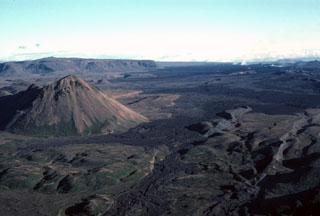Report on Krafla (Iceland) — January 1981
Scientific Event Alert Network Bulletin, vol. 6, no. 1 (January 1981)
Managing Editor: Lindsay McClelland.
Krafla (Iceland) Fissure eruption
Please cite this report as:
Global Volcanism Program, 1981. Report on Krafla (Iceland) (McClelland, L., ed.). Scientific Event Alert Network Bulletin, 6:1. Smithsonian Institution. https://doi.org/10.5479/si.GVP.SEAN198101-373080
Krafla
Iceland
65.715°N, 16.728°W; summit elev. 800 m
All times are local (unless otherwise noted)
". . . The ground level at which previous deflation events and eruptions were triggered was again reached about 10 January, but inflation continued.
"On 30 January at about 0700, slow deflation of the magma reservoirs started, as recorded by tiltmeters at the Krafla power plant. The rate of deflation rapidly increased and at about 0730 tremor appeared on seismometers. Deflation rate and tremor amplitude reached a maximum at about 0900 and declined very gradually thereafter. The earthquake epicenters indicated movement of magma along the fault swarm toward the N. Soon after 1400, a fissure eruption started in the fault swarm 8-9 km N of the center of the magma reservoirs. The fissure soon extended to 2 km length and the lava front quickly moved toward the N. The eruption site was close to those of July and October, 1980 and the eruptive behavior was broadly similar. In the morning of 31 January, the fissure had shortened to about 300-400 m and the lava production rate had decreased somewhat.
"The eruption and very slow deflation were continuing on 2 February. The eruption site is in an uninhabited area and poses no danger to the local population. Observations are hampered due to remoteness and difficult weather conditions."
Geological Summary. The Krafla volcanic system in the Northern Volcanic Zone (NVZ) of Iceland is about 100 km long, consisting of a fissure swarm and a central volcano with a 7 x 9 km caldera formed about 110,000 years ago that deposited a rhyolitic welded tuff. It has been moderately active in the Holocene, over three distinct eruptive periods; the current one has lasted about 2,800 years with six volcano-tectonic episodes, each with one or more basaltic fissure eruptions. Lava volumes (DRE) have been in the 0.1-1 km3 range. The Hverfjall and Ludent tuff rings east of Myvatn were erupted along the fissure system. Myvatn lake formed during the eruption of the older Laxarhraun lava flow from the Ketildyngja shield volcano of the Fremrinamur volcanic system about 3,800 years before present (BP); The present Myvatn lake is constrained by the roughly 2,000 years BP younger Laxarhraun lava flow from the Krafla volcanic system. The abundant pseudocraters that form a prominent part of the Myvatn landscape were created when the younger Laxarhraun lava flow entered the lake. The last eruption took place in 1975-1984 CE when nine small basaltic fissure eruptions produced 0.25 km3 of lava.
Information Contacts: K. Grönvold, NVI; P. Einarsson, Univ. of Iceland.

